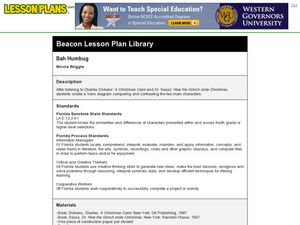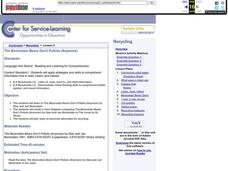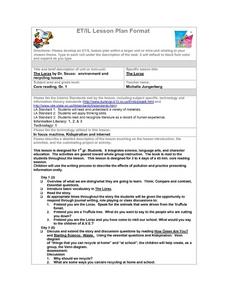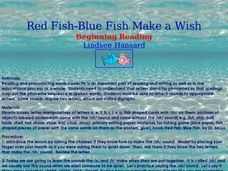Curated OER
Class Number Book
Students practice counting by ones. They find the numbers one through ten in a magazine or catalog. They put their picture into a classbook and they use it to practice counting.
Curated OER
Down by the Bay
Students listen to teacher read books about fish and participate in activities in order to explore how to identify bluefish. They count and graph the numbers of fish they find in simulated fishing activities.
Curated OER
Bah Humbug
Students listen to two famous stories about people who do not like Christmas, and then create a Venn diagram to compare and contrast the main characters.
Curated OER
Making Connections, Linking Population and the Environment
Pupils find out that all habitats have a carrying capacity. They explore how the world's human population has grown markedly in the 20th century, and that humans impact environmental health. Students investigate that people can and must...
Curated OER
Let's Sum It Up
Students summarize a selected piece of nonfiction text as a group. After reviewing the instructors preferred method for summarizing information by identifying the main idea and supporting details, groups write a summary paragraph of a...
Curated OER
The Berenstain Bears Don't Pollute (Anymore)
Students listen to the story, The Berenstain Bears Don't Pollute (Anymore). They create a Venn Diagram comparing it with the story, The Lorax. Then students plan ways to become advocates for recycling.
Curated OER
Environment and Recycling Issues
First graders read and understand the text found while conducting internet research. They recognize how literature records information and reflects the human experience. Students also compare and contrast answers to questions. Then...
Curated OER
Particulate Matter: The Lorax
Students collect air samples to test it for air pollution. They are read the story The Lorax and discuss the effects of air pollution. They share their observations with the class.
Curated OER
Red Fish-Blue Fish Make a Wish
Students to read and pronounce words correctly. They investigate the letters that stand for phonemes so that spellings map out the phoneme sequence in spoken words. Students attach sounds to appropriate letters. They have some sounds...










